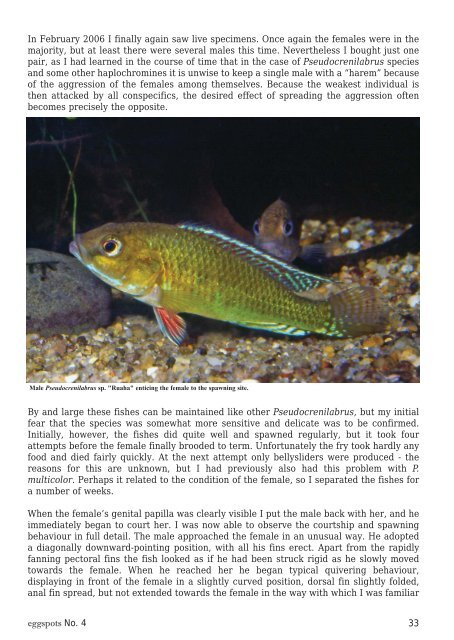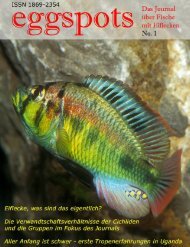Eggspots Elsewhere - Welt der Fische / World of Fishes
Eggspots Elsewhere - Welt der Fische / World of Fishes
Eggspots Elsewhere - Welt der Fische / World of Fishes
Create successful ePaper yourself
Turn your PDF publications into a flip-book with our unique Google optimized e-Paper software.
In February 2006 I finally again saw live specimens. Once again the females were in the<br />
majority, but at least there were several males this time. Nevertheless I bought just one<br />
pair, as I had learned in the course <strong>of</strong> time that in the case <strong>of</strong> Pseudocrenilabrus species<br />
and some other haplochromines it is unwise to keep a single male with a “harem” because<br />
<strong>of</strong> the aggression <strong>of</strong> the females among themselves. Because the weakest individual is<br />
then attacked by all conspecifics, the desired effect <strong>of</strong> spreading the aggression <strong>of</strong>ten<br />
becomes precisely the opposite.<br />
Male Pseudocrenilabrus sp. "Ruaha" enticing the female to the spawning site.<br />
By and large these fishes can be maintained like other Pseudocrenilabrus, but my initial<br />
fear that the species was somewhat more sensitive and delicate was to be confirmed.<br />
Initially, however, the fishes did quite well and spawned regularly, but it took four<br />
attempts before the female finally brooded to term. Unfortunately the fry took hardly any<br />
food and died fairly quickly. At the next attempt only bellysli<strong>der</strong>s were produced - the<br />
reasons for this are unknown, but I had previously also had this problem with P.<br />
multicolor. Perhaps it related to the condition <strong>of</strong> the female, so I separated the fishes for<br />
a number <strong>of</strong> weeks.<br />
When the female’s genital papilla was clearly visible I put the male back with her, and he<br />
immediately began to court her. I was now able to observe the courtship and spawning<br />
behaviour in full detail. The male approached the female in an unusual way. He adopted<br />
a diagonally downward-pointing position, with all his fins erect. Apart from the rapidly<br />
fanning pectoral fins the fish looked as if he had been struck rigid as he slowly moved<br />
towards the female. When he reached her he began typical quivering behaviour,<br />
displaying in front <strong>of</strong> the female in a slightly curved position, dorsal fin slightly folded,<br />
anal fin spread, but not extended towards the female in the way with which I was familiar<br />
eggspots No. 4<br />
33




